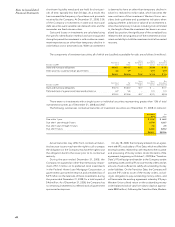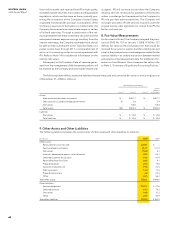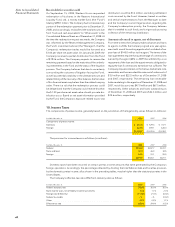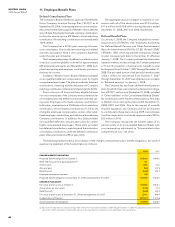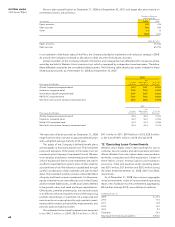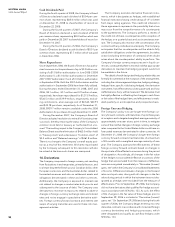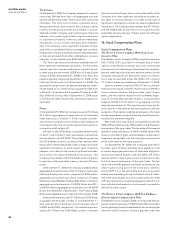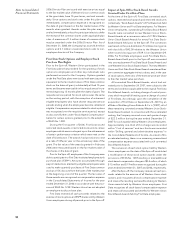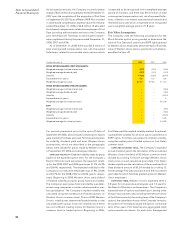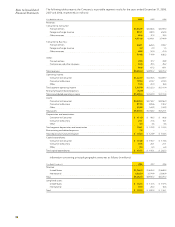Western Union 2008 Annual Report Download - page 72
Download and view the complete annual report
Please find page 72 of the 2008 Western Union annual report below. You can navigate through the pages in the report by either clicking on the pages listed below, or by using the keyword search tool below to find specific information within the annual report.WESTERN UNION
2008 Annual Report
7070
Cash Dividends Paid
During the fourth quarter of 2008, the Company’s Board
of Directors declared a cash dividend of $0.04 per com-
mon share, representing $28.4 million which was paid
on December 31, 2008 to shareholders of record on
December 22, 2008.
During the fourth quarter of 2007, the Company’s
Board of Directors declared a cash dividend of $0.04
per common share, representing $30.0 million which was
paid on December 28, 2007 to shareholders of record on
December 14, 2007.
During the fourth quarter of 2006, the Company’s
Board of Directors declared a cash dividend of $0.01 per
common share, representing $7.7 million which was paid
in December 2006.
Share Repurchases
Since September 2006, the Board of Directors has autho-
rized common stock repurchases of up to $3.0 billion con-
sisting of a $1.0 billion authorization in June 2008 (“2008
Authorization”), a $1.0 billion authorization in December
2007 (“2007 Authorization”) and a $1.0 billion authorization
in September 2006. Both the 2007 Authorization and the
authorization in September 2006 have been fully utilized.
During the years ended December 31, 2008, 2007 and
2006, 58.1 million, 34.7 million and 0.9 million shares,
respectively, have been repurchased for $1,313.9 million,
$726.5 million and $19.9 million, respectively, exclud-
ing commissions, at an average cost of $22.60, $20.93
and $22.78 per share, respectively. As of December 31,
2008, $939.7 million remains available under the 2008
Authorization for purchases through December 31, 2009.
During December 2007, the Company’s Board of
Directors adopted resolutions to retire all of its existing trea-
sury stock, thereby restoring the status of the Company’s
common stock held in treasury as “authorized but unis-
sued.” The resulting impact to the Company’s Consolidated
Balance Sheet was the elimination of $462.0 million held
in “Treasury stock” and a decrease in “Common stock” of
$0.2 million and “Retained earnings” of $461.8 million.
There is no change to the Company’s overall equity posi-
tion as a result of this retirement. All shares repurchased
by the Company subsequent to this resolution will also
be retired at the time such shares are reacquired.
14. Derivatives
The Company is exposed to foreign currency risk resulting
from fluctuations in exchange rates, primarily the euro, and
to a lesser degree the British pound, Canadian dollar, other
European currencies, and the Australian dollar, related to
forecasted revenues and also on settlement assets and
obligations denominated in these and other currencies.
Additionally, the Company is exposed to interest rate
risk related to changes in market rates both prior to and
subsequent to the issuance of debt. The Company uses
derivatives to minimize its exposures related to adverse
changes in foreign currency exchange rates and interest
rates and not to engage in speculative derivative activi-
ties. Foreign currency forward contracts and interest rate
swaps of varying maturities are used in these risk man-
agement activities.
The Company executes derivative financial instru-
ments, which it designates as hedges, with established
financial institutions having credit ratings of “A” or better
from major rating agencies. The credit risk inherent in
these agreements represents the possibility that a loss
may occur from the nonperformance of a counterparty
to the agreements. The Company performs a review of
the credit risk of these counterparties at the inception of
the hedge, on a quarterly basis and as circumstances war-
rant. The Company also monitors the concentration of its
contracts with any individual counterparty. The Company
anticipates that the counterparties will be able to fully
satisfy their obligations under the agreements, but takes
action (including termination of contracts) when doubt
arises about the counterparties’ ability to perform. The
Company’s foreign currency exposures are in liquid cur-
rencies, consequently there is minimal risk that appropriate
derivatives to maintain the hedging program would not
be available in the future.
The details of each designated hedging relationship are
formally documented at the inception of the arrangement,
including the risk management objective, hedging strategy,
hedged item, specific risks being hedged, the derivative
instrument, how effectiveness is being assessed and how
ineffectiveness, if any, will be measured. The derivative must
be highly effective in offsetting the changes in cash flows
or fair value of the hedged item, and effectiveness is evalu-
ated quarterly on a retrospective and prospective basis.
Foreign Currency Hedging
The Company’s policy is to use longer-term foreign cur-
rency forward contracts, with maturities of up to three years
at inception and a targeted weighted-average maturity of
approximately one year at any point in time, to mitigate
some of the risk that changes in foreign currency exchange
rates compared to the United States dollar could have on
forecasted revenues denominated in other currencies. At
December 31, 2008, the Company’s longer-term foreign
currency forward contracts had maturities of a maximum
of 24 months with a weighted average maturity of one
year. The Company assesses the effectiveness of these
foreign currency forward contracts based on changes in
the spot rate of the affected currencies during the period
of designation. Accordingly, all changes in the fair value
of the hedges not considered effective or portions of the
hedge that are excluded from the measure of effective-
ness are recognized immediately in “Derivative (losses)/
gains, net” within the Company’s Consolidated Statements
of Income. Differences between changes in the forward
rates and spot rates, along with all changes in the fair
value during periods in which the instrument was not des-
ignated as a hedge, were excluded from the measure of
effectiveness. Prior to September 29, 2006, the Company
did not have derivatives that qualified for hedge account-
ing in accordance with SFAS No. 133. As such, the effect
of the changes in the fair value of these hedges prior to
September 29, 2006 is included in “Derivative (losses)/
gains, net.” On September 29, 2006 and during the fourth
quarter of 2006, the Company began entering into new
derivative contracts in accordance with its revised foreign
currency derivatives and hedging processes, which
were designated and qualify as cash flow hedges under
SFAS No. 133.



